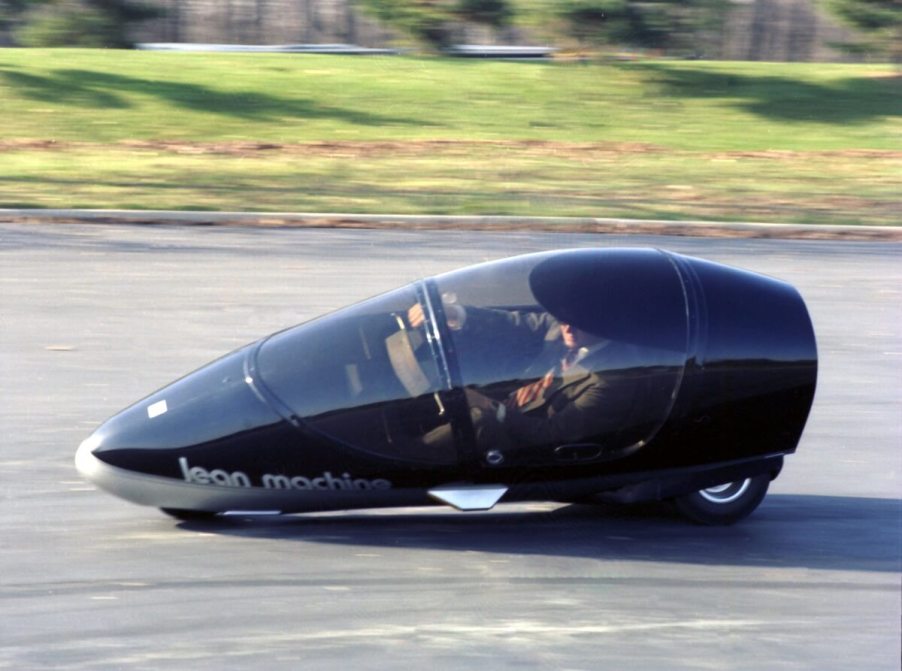
One of the Most Fuel-Efficient Cars in General Motors History Was a Single-Seat Rocket That Never Saw Production
In a post-pandemic era with volatile gas prices and endless distractions, one historic little vehicle at General Motors could’ve saved us: the fabled GM Lean Machine. With just one seat, the Lean Machine is the perfect social distancing device, isolated yet eager. Moreover, the unique little car’s revolutionary shape, low weight, and lack of power promised fuel economy figures in the triple digits– under the right conditions. So, what’s so special about the little fuel-sipper that GM never put into production?
What is the Lean Machine?

The General Motors Lean Machine is a single-seat, three-wheeled vehicle with an iconic tear-drop shape for maximum aerodynamic profile. Operators would slide into the diminutive machine by raising a canopy, not unlike a WWII-era Messerschmitt Bf 109 fighter plane. However, its footprint is a far cry from a large airplane.
| Weight | 350.535 lbs |
| Wheelbase | 71 inches |
| Length | 103 inches |
| Height | 47 inches |
| Engine | 185cc Honda Engine |
You read right; in 1982, the same year that General Motors put a Cross-Fire fuel-injected 350 V8 in a Batmobile-esque C3 Corvette, the Detroit giant put a Honda engine in its little concept. Of course, there’s a method behind the madness. The head visionary behind the little one-seater, Frank Winchell, saw the small engine and aero-friendly application as an efficient solution to malaise-era fuel issues.
OK, so looking cool and as different as they come? Check. Better yet, the “Lean” in Lean Machine comes from the weight-transfer action in cambering the little car around corners, similar to a motorcycle. However, even with promises of easy parking, protection from the weather that a motorcycle doesn’t provide, and triple-digit fuel economy, the Lean Machine never made it past the prototype and concept phase.
How fuel-efficient is the Lean Machine?

The General Motors Lean Machine with the fixed, non-cambering rear-end and a 15-horsepower engine could manage around 120 mpg, per Hemmings. However, General Motors asserted that the little leaner could theoretically accomplish 200 miles on a single gallon of gas.
The source of the little prototype’s extraordinary fuel efficiency figures? Shape, weight, and power (or lack thereof). A slimmer, leaning variant of the projectile-shaped car had a drag coefficient of just 0.15, around half as much as a standard sedan today.
Do any production gas cars get over 100 mpg?

Currently, there are no gas-powered production cars in the American market, with fuel economy figures anywhere close to 100 mpg. Instead, some of the most fuel-conscious, non-hybridized cars on the market won’t crack 40 combined mpg. For instance, TrueCar says the tiny, underpowered Mitsubishi Mirage will manage 39 mpg combined.
Why didn’t GM produce the Lean Machine?
Unfortunately, General Motors never put the Lean Machine into production. Instead, GM discontinued work on the project in the 1990s after producing six prototypes to focus on its lineup of more profitable conventional vehicles.
Still, the shocking shape of the little rocket-ish single-seater would have been fantastic to see on public roads, even in a limited capacity. In fact, the form is so interesting that Hot Wheels made a die-cast version of the car’s iconic torpedo silhouette.
What do you think of the GM Lean Machine? Share your thoughts in the comments below!



